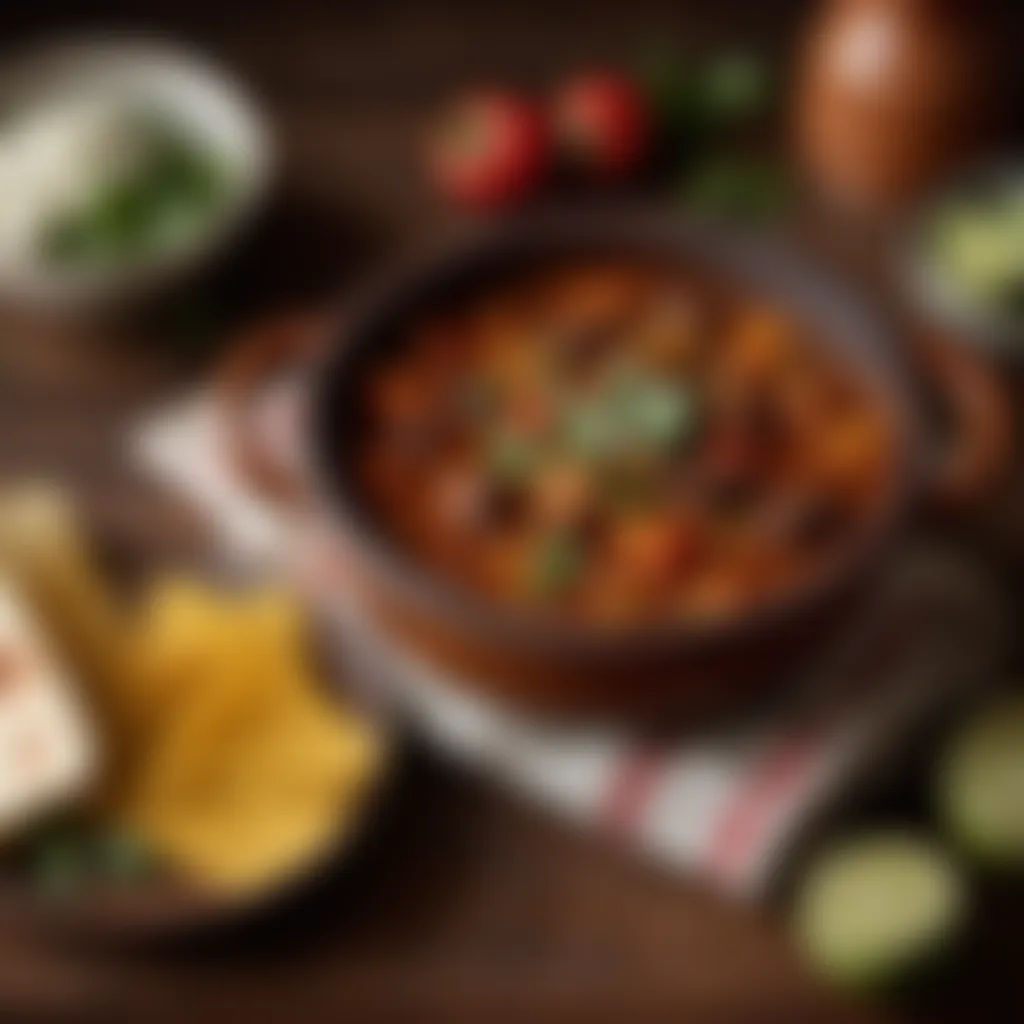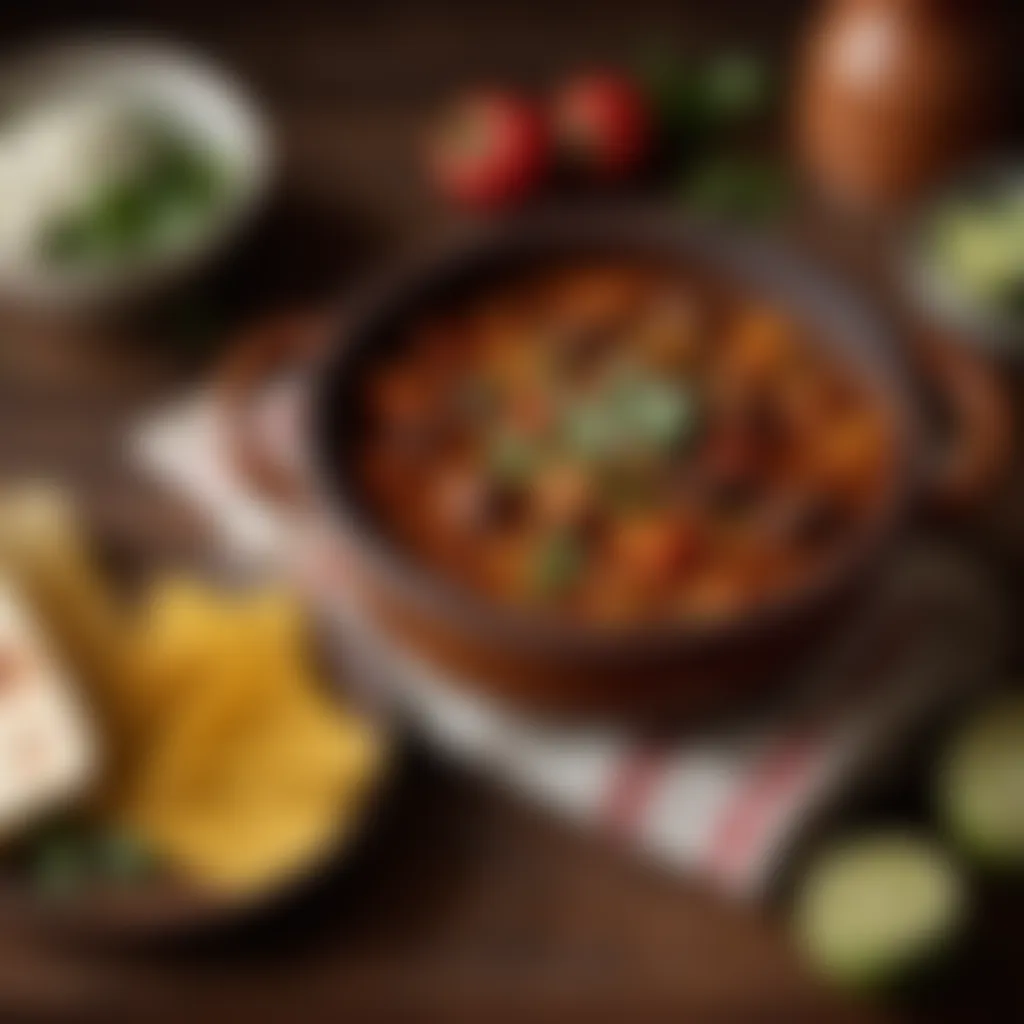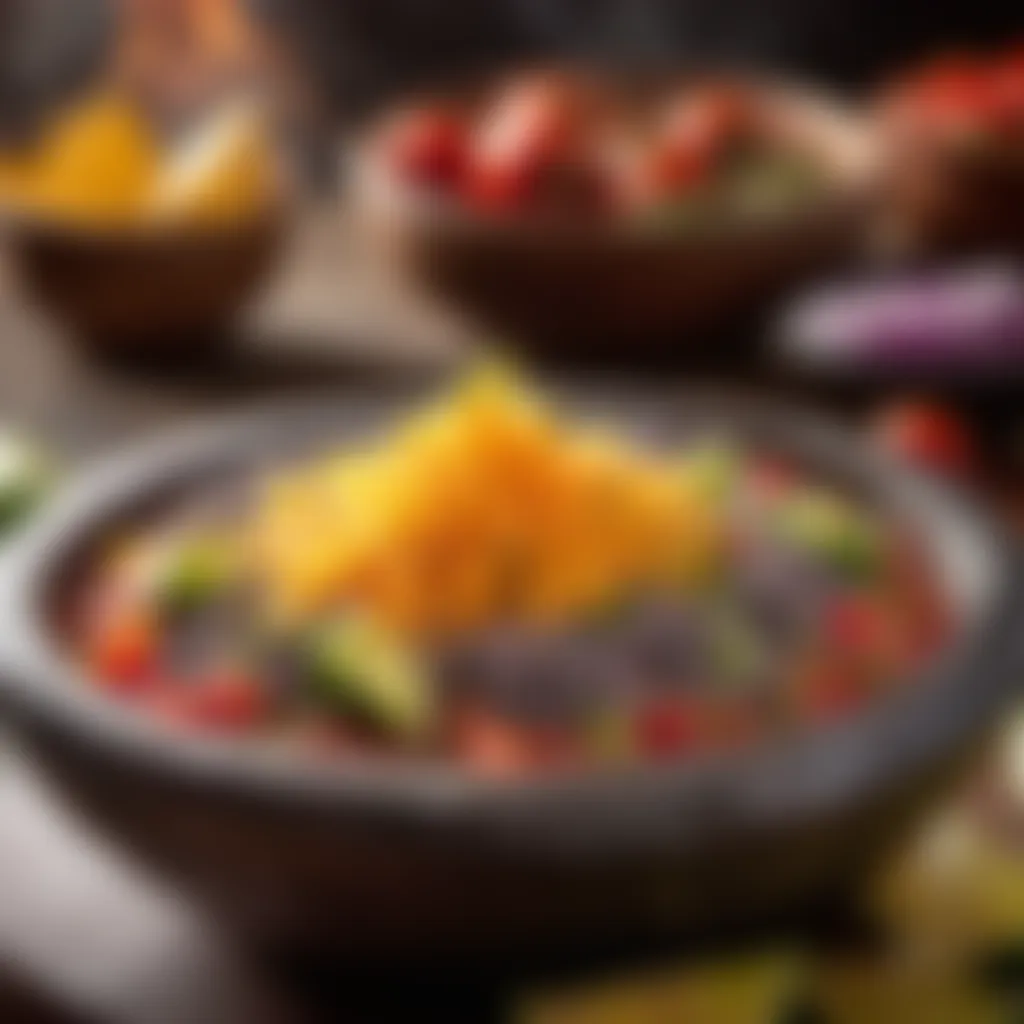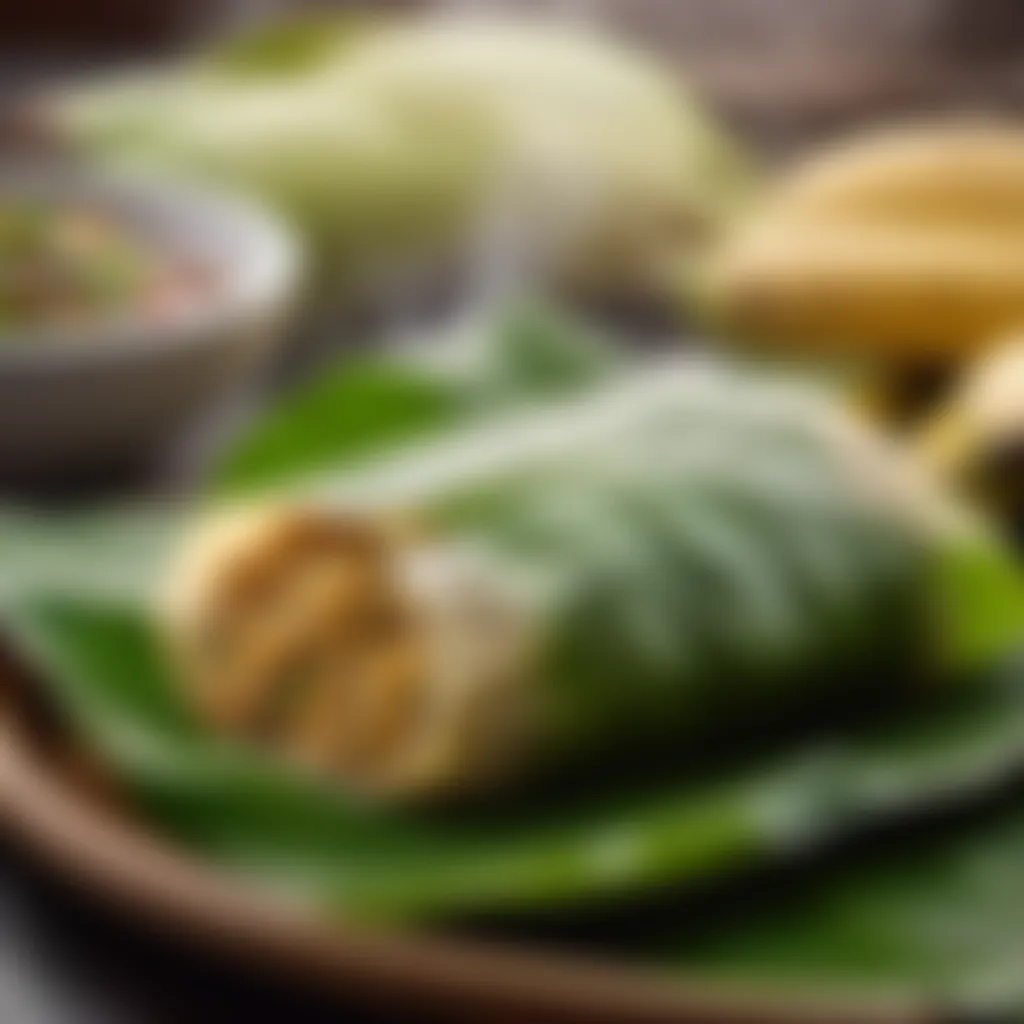Exploring Mexican Cooking Techniques and Traditions


Intro
Mexican gastronomy is more than just a meal; it’s a vibrant story that speaks of history, culture, and passion. Every tortilla, every mole, and every spoonful of salsa comes with a rich narrative tied deeply to the land and its people. Imagine walking through a bustling market in Mexico City, the air thick with the scent of spices and fresh produce. Picture the hands of a skilled cook kneading masa, or the rhythmic chopping of ingredients that blend harmoniously into a delectable dish. Understanding the intricate cooking techniques behind these culinary traditions is like peeling back layers of a captivating narrative. This journey will explore not only the ingredients and methods but the significance each facet carries in the larger tapestry of Mexican cuisine.
Ingredients:
To commence our culinary adventure, here’s a robust list of ingredients you’ll need. Take care to gather these items before diving into your cooking session:
- Corn (Maize): 2 cups of masa harina (corn flour)
- Water: 1 cup (adjust as needed)
- Salt: 1 teaspoon
- Tomatoes: 4 medium-sized, roasted and pureed
- Onions: 1 large, finely chopped
- Garlic: 3 cloves, minced
- Chili peppers: 2 medium, chopped (such as jalapeño or serrano)
- Meat (e.g., beef or chicken): 1 pound, diced
- Spices: Cumin (1 teaspoon), oregano (1 teaspoon), and black pepper (1/2 teaspoon)
- Lime: 2, juiced
- Cilantro: 1/4 cup, chopped (for garnish)
- Cheese: 1 cup crumbled queso fresco (optional)
Preparation Steps:
Step 1: Begin with the Basics
Start by preparing the corn for your masa. In a sizable bowl, combine masa harina with water and salt. Knead until you achieve a smooth dough. This masa is the heart of many Mexican dishes, creating tortillas and tamales that serve as vessels for flavor.
Step 2: Prepare the Filling
In a hot skillet, introduce a splash of oil. Sauté the onions and garlic until translucent. Next, add the diced meat along with chopped chilies, cooking until the meat is browned. Stir in the pureed tomatoes, spices, and lime juice. Let this mixture simmer for approximately 15 minutes, allowing the flavors to mingle beautifully.
Technical Aspects:
Temperature Settings:
- Start your skillet on medium heat to sauté the onions and garlic.
- When simmering the sauce, reduce to low heat to avoid burning while allowing flavors to deepen.
Timing Specifics:
- Kneading masa should take about 5-10 minutes, ensuring elasticity.
- Let the filling simmer for no less than 15 minutes. Taste and adjust seasoning as necessary!
Cooking Process:
Step 3: Form Tortillas
Once your masa is ready, take small portions and roll them into balls. Using a tortilla press or rolling pin, flatten each ball between two sheets of plastic until you achieve a perfect circular thin disc.
Step 4: Cook Tortillas
Heat a comal or non-stick skillet over medium-high heat. Place the flattened masa into the skillet, cooking for about 30 seconds on each side, or until you see brown specks forming. Flipping these tortillas often ensures they cook evenly.
Step 5: Assemble the Dish
Now comes the fun part! Take your cooked tortilla and add a generous helping of the meat mixture in the center. If you’d like, sprinkle some queso fresco and cilantro on top before folding or rolling the tortilla.
Troubleshooting Tips:
- Tortillas sticking: If your tortillas are sticking to the skillet, ensure your comal is adequately heated and slightly oiled.
- Flavor too acidic: If your sauce tastes overly sour, consider adding a pinch of sugar to balance the flavors.
"Cooking is not just about the food; it’s about the experience and the stories that come with it."
By following these steps meticulously, you can dive into the flavors and textures that paint the picture of Mexican cuisine. Whether you serve it with a side of fresh guacamole or a zesty salsa, each bite carries a piece of its cultural heritage, inviting you to savor the culinary artistry that defines this beloved gastronomy.
Preface to Mexican Gastronomy
Mexican gastronomy is not just about the food served on a plate; it’s a vibrant expression of the country’s history, culture, and social fabric. This introduction sets the stage for understanding the intricate cooking techniques deeply rooted in the lives of its people. The importance of knowing these methods extends beyond mere recipes; it is about experiencing food as a multi-sensory journey that connects one to generations past.
Historical Context
The story of Mexican gastronomy is woven into the history of the land itself. From the ancient Mesoamericans who cultivated corn, beans, and chili, to the Spanish colonizers who introduced various ingredients, the evolution of this cuisine has been profoundly influenced by diverse cultures.
This synthesis of foodways is evident when examining traditional techniques. For instance, the nixtamalization process, used for preparing corn, has been practiced for over 3,000 years. It highlights the resourcefulness of ancient communities while enhancing the nutritional value of the maize, crucial for their diets.
One might say that each dish carries a whisper of history—like a well-worn book with tales tucked within its pages. The spices, ingredients, and methods have changed and adapted over centuries, offering a rich tapestry of flavors that tell the story of the people and their land.
Cultural Significance
Food in Mexico serves not only to satisfy hunger but also to strengthen social bonds. Meals bring families together and honor traditions; they create a space for storytelling and sharing memories. This cultural significance is mirrored in various rituals and celebrations, such as Día de los Muertos, where specific dishes are prepared to honor deceased loved ones.
Moreover, the regional diversity in Mexican cooking reflects a rich cultural heritage. From the intricate mole of Oaxaca to the zesty dishes of Yucatán, every locality has unique ingredients and cooking methods shaped by geography and history.


"Food is a central part of our identity; it tells where we are from and who we are."
Fundamental Principles of Cooking
Understanding the Fundamental Principles of Cooking is essential for anyone keen on mastering Mexican gastronomy. This foundational knowledge not only enriches a cook's repertoire but also ensures that each dish is prepared with intention and respect for its cultural roots. These principles encompass the essential aspects of ingredient selection and flavor balancing, which are invaluable in capturing the essence of what makes Mexican cuisine so vibrant.
Ingredient Selection
Regional Variations
Regional Variations play a pivotal role in Mexican cooking. Different regions of Mexico boast diverse climates and natural resources, influencing the ingredients available. For instance, coastal areas like Veracruz thrive on seafood, lending a unique twist to classic dishes. In contrast, inland regions such as Puebla emphasize ingredients like beans and corn, celebrated staples that form the backbone of many recipes.
One key characteristic of regional variations is their embodiment of local terroir. It’s not just about what’s available; it’s about food identity and cultural heritage. Utilizing local ingredients supports fresh, hearty meals, and fosters a stronger connection to the community. The benefits here are significant: utilizing local produce mean fresher flavors and often more nutritional value.
However, a reliance on regional specific ingredients also has downsides. Those in urban settings or outside of Mexico may find certain items harder to come by. The search for authentic flavors can become a daunting task without access to local markets. Nonetheless, understanding these regional characteristics elevates the cooking experience, enriching the meal with stories from different cultural backgrounds.
Seasonal Availability
Seasonal Availability is another critical element, emphasizing the importance of cooking with fresh produce at its peak. Each season in Mexico introduces distinct agricultural offerings, marking a rhythm in the kitchen that corresponds to nature’s cycles. For example, spring offers an abundance of fresh herbs and vegetables, while fall often sees the harvest of chiles and root vegetables.
The key characteristic here lies in the freshness of ingredients, which translates to improved taste and nutritional profile. Cooking according to the seasons not only reflects a respect for nature but allows cooks to tap into the flavors that are naturally at their best. This practice also minimizes the dependency on preserved goods and enhances sustainability in food preparation.
The unique feature of emphasizing seasonal ingredients is that it encourages flexibility in recipes. When certain elements are out of season, substitutions can lead to creative innovations in traditional dishes. However, the challenge arises in maintaining consistency in flavors year-round, as ingredients fluctuate based on availability.
Flavor Balancing
Spice Usage
Spice Usage is fundamental to achieving the quintessential flavor profiles found in Mexican cuisine. Spices like cumin, coriander, and of course, the famous varieties of chiles, add depth and complexity that define numerous dishes. The inflection of flavor through spices is vital; it allows the cook to manipulate and enhance the dish dynamically.
A significant characteristic of using spices is their ability to evoke and enhance the natural flavors of other ingredients. Each region often has traditional spice blends that speak to its unique culinary identity, such as the Oaxacan mole which can include up to twenty ingredients! This complexity can usher in layers of taste that tell stories of cultural significance and folk traditions, making it a beneficial practice for those looking to delve deeper into this gastronomic field.
On the downside, an avid use of spices requires a delicate balancing act. Too much spice can overpower a dish, causing it lose its intended character. Moreover, the heat levels from spices can vary between types and even batches, which may challenge consistency in recipes.
Acidity and Sweetness
Finding the right equilibrium between Acidity and Sweetness is crucial in Mexican cooking. Lime juice, for instance, is a common way to introduce acidity, cutting through rich flavors and elevating freshness in dishes like ceviche or tacos. Conversely, the sweetness found in fruits like mango or ingredients like sugar can soften spicy dishes and create a harmonious profile.
The key here is that both acidity and sweetness create a balanced palate. They enhance the overall culinary experience, ensuring that no single flavor dominates the dish. Much like spices, these elements allow cooks to craft traditional dishes while appealing to a range of tastes, which makes it invaluable.
Nonetheless, it's easy to misjudge these flavor profiles. Overemphasis on acidity can leave a dish tasting brash or overly sharp, while too much sweetness can mask more subtle flavors. Mastering this balance is vital for anyone looking to cook Mexican dishes authentically.
"Cooking is an act of translation—what is unfolding on the plate should speak subtleties of flavor and history, bridging the home and the cultural landscape."
In summary, understanding and applying the principles of ingredient selection and flavor balancing fosters a deeper appreciation for Mexican gastronomy. By lifelong commitment to mastering these fundamentals, cooks not only honor the traditions of the cuisine but also enhance their culinary skills with every simmer and sauté.
Traditional Cooking Techniques
Traditional cooking techniques are the cornerstones of Mexican gastronomy, offering a rich framework through which culinary traditions thrive and evolve. They provide a unique identity to various dishes, reflecting the history, culture, and natural resources of different regions. These techniques not only enhance flavor and texture but also ensure that food is prepared in a way that honors age-old practices passed down through generations. In a world where fast food dominates, these methods emphasize the value of patience and authenticity.
Nixtamalization Process
Importance of Corn
Corn is the heart and soul of Mexican cooking, playing a pivotal role in its gastronomy. Much more than just a staple, it represents a cultural symbol of sustenance, resilience, and community. One key characteristic of corn is its versatility; it can be ground into masa for tortillas, used in tamales, or even enjoyed as elote on the cob.
The process of nixtamalization enhances corn's nutritional value, making it a beneficial choice for food preparation. This method involves soaking and cooking corn in an alkaline solution, usually limewater, which not only softens the kernels but also releases important nutrients like niacin. The unique feature of this process is how it transforms the flavor of corn, adding a distinct taste that's integral to many dishes. However, it's worth noting that the method requires time and careful attention, which can be a disadvantage for those seeking a quick fix in the kitchen.
Chemical Changes
The chemical changes that occur during nixtamalization are fascinating and important to understand. When corn is treated with lime, the alkaline environment alters the structure of the corn, allowing for increased availability of proteins and vitamins. This process also aids in reducing toxins, which is critical for health.
The pivotal characteristic of these chemical changes lies in the enhancement of flavor and texture, making the result more palatable and digestible. For audiences invested in the nuances of cooking, this characteristic demonstrates that understanding the science behind the cooking techniques not only enriches the culinary experience but also elevates the nutritional value of meals. Still, the complexity of executing these changes requires a level of careful procedure and expertise that might not appeal to all home cooks.
Slow Cooking Methods
Types of Dishes
Slow cooking methods bring out the best in many traditional Mexican dishes. The kind of dishes that benefit the most include stews, braises, and traditional mole sauces. These dishes are perfect for cooking long and slow, absorbing a variety of spices and flavors that create a depth that cannot be rushed.


A standout characteristic of slow cooking is its ability to create tender meat infused with the rich flavors of spices and aromatics. Popular examples include pozole and birria, which are labor-intensive yet rewardingly rich in flavor. The unique feature of this method—allowing ingredients to meld together over hours—means that while it requires a time commitment, the results are always worthwhile and full of rich, layered flavors.
Flavor Development
Flavor development in slow cooking happens gradually and effortlessly, allowing spices to bloom and meld into one another. The key aspect is that the slow heat breaks down tougher cuts of meat and integrates seasoning deeply into the dish.
This gradual blending of flavors is a popular choice for creating complex, satisfying meals that resonate with the heart and soul of Mexican cuisine. The unique feature of slow cooking is its ability to craft deep, savory flavors without the need for excessive ingredients. It emphasizes the beauty of simplicity while showcasing its rewards, making it a cherished technique for those looking to achieve culinary authenticity.
Grilling and Roasting Techniques
Traditional Equipment
Grilling and roasting are deeply ingrained techniques in Mexican cooking, often executed with traditional equipment like the comal or clay earthenware ovens known as "horno." These implements help to impart a unique flavor profile that is hard to replicate with modern appliances.
A key characteristic of this traditional equipment lies in its ability to retain and distribute heat evenly, bringing the flavors of ingredients to life. Using such equipment can be a beneficial choice for the authentic preparation of various dishes ranging from grilled meats to roasted vegetables. The hands-on approach of utilizing these tools adds a layer of connection to the food, bridging the past with present culinary practices.
Flavor Infusion
The flavor infusion that comes from grilling and roasting is truly remarkable. As ingredients are exposed to flames or the intense heat of a traditional oven, a caramelization occurs, transforming the natural sugars and enhancing the overall taste.
One of the standout characteristics of this technique is how it locks in juices, yielding succulent outcomes. The unique feature here is the charred exterior that adds complexity to flavor profiles. Though occasionally this method can lead to uneven cooking if not monitored, the reward is a deliciously smoky taste that enriches dishes and highlights the essence of the ingredients used.
Regional Specialties
Exploring the regional specialties in Mexican gastronomy opens an exciting door into the varied tapestry of flavors, methods, and traditions that shape the culinary landscape of the country. Each region boasts its own unique ingredients and techniques, offering a glimpse into the culture and history of its people. By understanding the specialties from different areas, one can appreciate how geography, climate, and local customs converge to create distinctive dishes that are not just meals but a celebration of heritage and identity.
Oaxacan Cuisine
Mole Varieties
Mole is one of the most iconic elements in Oaxacan cuisine, cherished for its complexity and richness. The variety of moles, such as Mole Negro or Mole Rojo, showcases a blend of flavors—from sweet to spicy—making it a versatile sauce for numerous dishes. Each mole is unique due to its diverse ingredients, often including chocolate, nuts, seeds, and a rich array of spices. This specificity makes mole a popular choice in Mexican gastronomy, as it brings depth and character to any meal.
The unique feature of mole lies in its labor-intensive preparation, where ingredients often need to be roasted, ground, and simmered for hours, resulting in a sauce that envelops the palate in various flavors. However, this complexity can also present a challenge for home cooks who may not have the time for such extensive preparation, making ready-made options a viable alternative.
Cheese-making Practices
The cheese-making tradition in Oaxaca is significant, particularly regarding the famous Quesillo, which is a fresh, string cheese that can be pulled and stretched. It is not just a delightful topping; it is integral in many Oaxacan dishes, adding a unique texture and flavor. The practice of cheese-making here takes advantage of local ingredients and reflects the pastoral lifestyles of the region.
What makes these practices beneficial is the artisanal approach, where many family businesses pass down techniques through generations. This method emphasizes quality and authenticity. However, one must consider the accessibility of fresh ingredients, which can limit how widely these cheeses are prepared outside of local contexts.
Yucatecan Dishes
Recado Sauce
Recado sauce represents the heart of Yucatecan cooking, boasting a distinct flavor profile that often differs from the more common salsas found elsewhere in Mexico. Made with ingredients like dried chiles, spices, and sometimes even seeds, it's essential for dishes like Cochinita Pibil. This sauce adds a depth of flavor and a kick that can transform a simple meal into something extraordinary.
The unique aspect of Recado sauce lies in its versatility; it can be used as a marinade or a cooking sauce, making it an essential ingredient for nurturing that robust Yucatecan style. But the ingredients' availability can be a concern, especially for those looking to recreate the dish far from the Yucatán Peninsula.
Pibil Cooking Method
The Pibil cooking method involves wrapping marinated meat in banana leaves and slow-cooking it, often underground in a pit. This technique draws out deep flavors and keeps the meat moist and tender, making it a hallmark of Yucatecan cuisine, especially for preparing dishes like Cochinita Pibil and Pibil Chicken.
One key characteristic of this method is how it infuses the food with the earthy notes of banana leaves, creating a unique aroma and taste. Its popularity lies in its communal aspect, where families or groups often gather to enjoy the prepared feast. Nevertheless, the preparation requires a good deal of time and space, which can pose a challenge for those with a conventional kitchen setup.
Jalisco’s Signature Foods
Tequila and its Culinary Use
Tequila, often celebrated as Mexico's spirit, also weaves itself into culinary practices within Jalisco. It's not just meant for pouring in shot glasses; chefs incorporate it into sauces, marinades, and even desserts to impart its unique agave flavor. Known for enhancing the complexity of dishes, tequila offers a flavor that's both sharp and sweet, standing as an essential element in modern Mexican recipes.
The benefit of using tequila in cooking lies in its ability to marry flavors, bringing dishes to a new level of sophistication. However, it’s important to choose high-quality tequila for cooking because lower-grade brands may impact the overall taste negatively.
Birria Preparation
Birria is emblematic of Jalisco, a savory stew typically made with goat meat, though variations with beef or lamb exist. The method of preparing birria often involves marinating the meat overnight in a rich blend of spices and then cooking it slowly to let the flavors meld beautifully. This dish has transcended regional boundaries, finding popularity in numerous settings.
The unique aspect of birria preparation is the combination of layers of flavor built through slow cooking and robust spices. Its rich aroma wafts through kitchens, creating an inviting atmosphere. It's worth mentioning that while delightful, the lengthy cooking time might not suit everyone’s fast-paced lifestyle, often making it a dish reserved for gatherings or special occasions.
Tools and Equipment in Mexican Cooking


Understanding the tools and equipment essential in Mexican cooking is crucial for anyone looking to master these intricate culinary techniques. These tools aren't just random gadgets; they’re extensions of the cook's hands, deeply intertwined with the cultural heritage and traditional practices of Mexican gastronomy. A good set of tools can enhance the cooking experience, making it more efficient and allowing for an authentic rendering of flavors. In this section, we will look at three important items that play a significant role in this vibrant culinary landscape.
Molcajete Usage
The molcajete is more than just a mortar and pestle; it’s a piece of history. Crafted from volcanic rock, its rough surface makes it ideal for grinding spices and preparing salsas. Not only does it facilitate texture, but it also enhances flavor, allowing ingredients to release their essential oils. The act of using a molcajete is somewhat of a ritual—it requires patience and an understanding of movement.
When working with a molcajete, you’re advised to follow a simple process:
- Start with dry spices: Toast them lightly in the comal for added depth.
- Add aromatics: Ingredients like garlic or onion can be ground down alongside the spices.
- Introduce fresh herbs: Finally, herbs like cilantro or parsley can be combined for the finishing touch.
The result is a rich, textured salsa or seasoning that speaks to the heart of traditional Mexican flavors. It’s a tool that not only serves culinary purposes but also connects the user to a lineage of traditional cooking techniques.
Comal Utilization
A comal is essential for anyone serious about Mexican cooking. This flat griddle, typically made of cast iron or clay, is used primarily for heating tortillas but has a wider array of uses. The comal allows for even heating, vital for achieving that satisfying char on food items.
Here’s a quick guide on how to utilize a comal effectively:
- Preheat: Make sure the comal is hot before placing tortillas on it, allowing them to puff and develop a delicious flavor.
- Cooking vegetables: Vegetables can also be grilled on the comal, which enhances their sweetness and gives them a smoky aroma.
- Warming spices: Toasting spices on a comal before grinding them can make a world of difference in terms of flavor intensity.
Using a comal connects one not just to the food itself, but also to communal experiences—think of gathering around it, sharing stories, and enjoying food cooked with love.
Cocineras and Their Importance
Cocineras, or traditional Mexican cooks, often serve as the backbone of culinary heritage. They are the custodians of recipes passed down through generations, forming a bridge between past and present. Their kitchens are usually equipped with traditional tools, crucial for recreating authentic dishes. The role of cocineras goes beyond just preparing food; they often embody the heart of community gatherings and celebrations.
Here are a few insights into their role:
- Knowledge Keepers: Cocineras are known for their extensive knowledge of ingredients and regional preparations, often being aware of specific variations that enhance flavor.
- Culinary Educators: Many cocineras share their expertise through cooking classes, keeping the culinary traditions alive for future generations.
- Cultural Icons: By participating in local festivals and markets, cocineras promote their culinary practices as expressions of cultural pride.
"A meal prepared by a cocinera is not just food; it’s a reflection of a community’s values and history."
In discussing tools and equipment in Mexican cooking, it becomes clear that these items are not mere objects but rather integral parts of a rich culinary narrative, each carrying its significance in the vibrant tapestry of Mexican gastronomy.
Modern Influences and Innovations
The world of Mexican gastronomy is not stagnant; it evolves and adapts as influences flow in from various corners of the globe. Modern influences and innovations breathe new life into traditional cooking techniques, merging age-old practices with contemporary ideas. This section dives into how these transformations are reshaping the culinary landscape of Mexico, making it both exciting and relevant to today’s food seekers.
Fusion Cuisine
Fusion cuisine takes center stage in the modern age, where culinary boundaries blur. It’s an invitation for chefs and home cooks alike to play around with flavors from different cultures. One striking aspect is how it brings together ingredients and cooking techniques from Mexican and other international cuisines, creating innovative dishes that pay homage to multiple traditions.
- Integrating Other Culinary Traditions
The beauty of integrating other culinary traditions is that it not only enhances the table with diverse flavors but also forms a conversational bridge between cultures. For instance, think of a taco with Korean BBQ beef or a tamale with jerk chicken. These combinations express a willingness to embrace the unfamiliar, making it a popular choice among adventurous food enthusiasts. Yet, there is a unique challenge: maintaining authenticity while charging towards innovation. This balancing act often presents an advantage—it piques interest while providing a fresh take on familiar flavors. - Contemporary Adaptations
Contemporary adaptations reflect how eating habits and preferences shift over time. As public awareness about health and nutrition rises, adaptations like quinoa tacos or gluten-free enchiladas have emerged, catering to the health-conscious crowd without sacrificing taste. This shift is beneficial because it draws in those who may typically shy away from traditional Mexican fare. However, one must be cautious not to reduce the essence of what makes these dishes special. Embracing innovation while upholding cultural significance is what makes contemporary adaptations truly exciting.
Health and Sustainability
The pressing importance of health and sustainability cannot be glossed over in today’s culinary discussions. Mexican gastronomy is increasingly aligning with these principles, reflecting a collective shift towards better eating habits and environmental responsibility.
- Organic Farming Practices
Organic farming practices hold significant weight in the current discourse on sustainability. The preference for natural fertilizers and pesticides is not merely a trend; it prioritizes the quality of produce, which can elevate traditional dishes. Using organic ingredients leads to a richer, more robust flavor profile, honoring the land and its offerings. It is a beneficial approach as it contributes to better health for both consumers and the environment. Nevertheless, cultivating organic produce requires patience and a learning curve, which may not always align with immediate convenience. - Health-Conscious Cooking
Health-conscious cooking has emerged as a response to the changing landscape of dietary needs and preferences. From utilizing lean meats to incorporating more vegetables into traditional recipes, this approach embraces a holistic view of well-being. Dishes like zucchini enchiladas serve as a fitting example, allowing diners to indulge guilt-free. The key characteristic here is balance—ensuring flavors are vibrant without compromising health. While some might argue that it alters the traditional taste, many find that these healthier options can offer a refreshing take on the classics.
"Embracing modern influences in Mexican cuisine does not mean losing roots; it often means celebrating them in new ways."
Both fusion cuisine and health-centric practices signify a dynamic evolution within Mexican gastronomy. These changes do not erase the essence of traditional dishes; rather, they add new layers of flavor and consciousness, appealing to a wider audience while respecting a rich heritage. As the culinary world continues to evolve, it invites us into a delicious dialogue of flavors and values.
Closure: The Legacy of Mexican Culinary Art
The art of Mexican cooking is as vibrant and complex as its history and culture. It is a stunning tapestry woven with threads of tradition, innovation, and regional prowess. The legacies of these culinary practices are not merely recipes handed down through generations; they are living stories that reflect the richness of Mexican heritage. They serve not only to nourish but to act as a canvas for identity and expression. By appreciating this culinary art form, we acknowledge the deep cultural significance that each dish holds—it's about more than just ingredients.
Preservation of Traditions
In today’s fast-paced world, the preservation of traditional cooking techniques is paramount. Think of a family gathering where a grandparent shares tales alongside the preparation of a cherished dish; it’s an invaluable moment that sustains cultural identity. Preserving these traditions ensures that the soul of Mexican cuisine endures. From the nixtamalization of corn that has been practiced for centuries to the slow cooking methods that infuse flavors like no other, these techniques encapsulate the essence of Mexican gastronomy.
Local communities and families play a pivotal role. Many strive to keep these customs alive through workshops, local markets, and farms. This grassroots effort not only benefits the culinary landscape, but it also fortifies bonds within communities, tattooing their shared histories onto each plate. Also, educational institutions are increasingly recognizing the importance of teaching these methods, ensuring that the next generation grows up understanding the roots of their culinary heritage.
The Future of Mexican Gastronomy
As we look ahead, the future of Mexican gastronomy appears bright, yet it’s laced with challenges. The rise of fusion cuisine showcases a fascinating blend of cultures coming together, creating unique culinary expressions. However, it’s crucial to navigate this waters carefully. Incorporating influences from elsewhere can enrich the culinary landscape, but it should be done while respecting the foundation of traditional practices.
Sustainability also takes center stage in conversations about the future. With organic farming becoming more prevalent, chefs and home cooks alike are focusing on sourcing local ingredients. This not only supports local economies but also minimizes environmental impact, making every meal not just a dish but a conscious choice.
Furthermore, as health consciousness rises among individuals, Mexican gastronomy can adapt. By promoting healthier versions of traditional dishes without losing authenticity, chefs are redefining what it means to enjoy Mexican cuisine in the modern era. The balance of tradition and innovation can lead to a culinary renaissance that respects history while proudly stepping into the future.
In the grand kitchen of life, every recipe tells a story, and every meal shared breaks barriers, keeping the arts of Mexican cooking alive.
In summation, the legacy of Mexican culinary art is multifaceted. It encompasses the beauty of tradition, the necessity of adaptation, and the importance of sustainability. Each dish, each technique, serves as a bridge between generations, ensuring that the essence of Mexican gastronomy not only survives but thrives.







